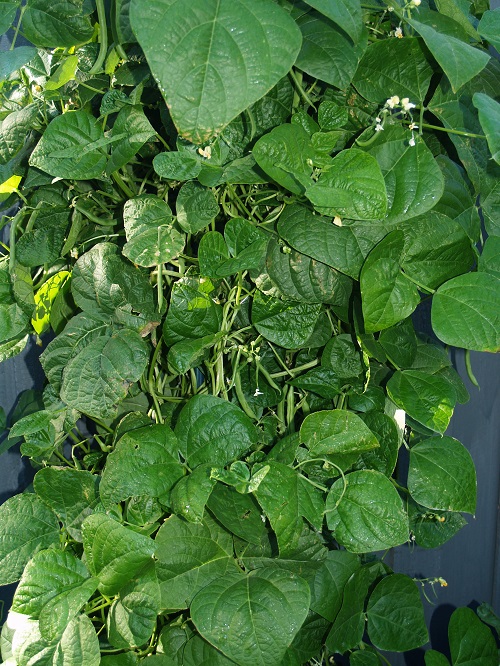Growing Beans Year Round
 For the home vegetable garden, the most widely grown beans are usually common (green) beans, runner beans, and broad beans. The common bean is known by a number of other names including green beans, French beans, haricot beans, flageolet, and string beans. They are all cultivars of Phaseolus vulgaris. Most green beans have a compact or bushy growth habit and are referred to as ‘bush beans’, or sometimes ‘dwarf beans’. Some cultivars have a climbing habit and are known as pole beans. Runner beans, Phaseolus coccineus, are also climbers. They have striking red flowers which have made them popular as ornamental vines as well as vegetable crops. Broad beans, Vicia faba, go by many other names like faba beans, fava beans, horse beans, field beans and English beans. It all depends where you live. In Australia, New Zealand and the UK, broad bean is the preferred name whereas in the United States they are called fava beans.
For the home vegetable garden, the most widely grown beans are usually common (green) beans, runner beans, and broad beans. The common bean is known by a number of other names including green beans, French beans, haricot beans, flageolet, and string beans. They are all cultivars of Phaseolus vulgaris. Most green beans have a compact or bushy growth habit and are referred to as ‘bush beans’, or sometimes ‘dwarf beans’. Some cultivars have a climbing habit and are known as pole beans. Runner beans, Phaseolus coccineus, are also climbers. They have striking red flowers which have made them popular as ornamental vines as well as vegetable crops. Broad beans, Vicia faba, go by many other names like faba beans, fava beans, horse beans, field beans and English beans. It all depends where you live. In Australia, New Zealand and the UK, broad bean is the preferred name whereas in the United States they are called fava beans.
Being legumes, part of the Fabaceae family of plants, they improve soil. That is, they have nitrogen-fixing bacteria on their root nodules. These bacteria capture atmospheric nitrogen which the plants use to make proteins. When the plant dies after bearing its fruits, if you leave it in the soil and dig it in, the remaining nitrogen is returned to the soil as the plant material breaks down. It therefore acts as a fertiliser and is why legumes are ideal plants to include in crop rotations.
Common beans are warm season crops. They grow well in temperatures from around 15°C - 59°F through to 29°C – 84.2°F, depending on the cultivar. Broad beans and runner beans, on the other hand, are cooler season crops. They need temperatures in the range of 7°C – 44.6°F to 23°C – 73.4° to grow. You can sow broad beans from autumn through to the end of winter, or autumn only in very warm places. Runner beans only grow well in cooler regions. Common beans may be sown from spring through to the end of summer, or all year round in the warmest climates.
Common Bean (Phaseolus vulgaris syn. Green Bean, French Bean, String Bean, Haricot Bean)
Beans are fast-growing crops, so you don’t have to wait too long to reap the rewards of your labour. The pole types are high yielding beans that can be harvested after about 10-12 weeks. A 3-5 metre row of beans will feed the average family for about one month.
Varieties
Different varieties need different temperature conditions but most need warmer weather. Blue Lake varieties can grow well in cooler areas. As well as green coloured beans there are others with purple, red-spotted or yellow pods. Those with yellow pods are also called ‘wax beans’. Some to try are as follows.
- Bush types: Blue Lake Bush, Provider, Cherokee Wax (yellow seed pods), Windsor Long Pod, Valdor (yellow seed pods)
- Pole types: Purple King (purple seed pods), Kentucky Wonder, Kentucky Blue, Blue Lake Pole, Vitalis, Westralia
Runner Bean (Phaseolus coccineus)
Runner beans are climbing or twining leafy plants with generally large, tasty seed pods. They differ to common beans in that they are actually perennials but nevertheless they are usually treated as annuals when grown as vegetables. They are excellent space savers as a crop, due to their upright growth habit.
Varieties
If you want to try growing these beans, look out for: Scarlet Runner or Scarlet Emperor
Broad Bean (Vicia faba syn. Faba Bean, Fava Bean, Horse Bean, English Bean, Windsor Bean)
Broad beans are leafy annuals which reach 1-2m tall. In recent years, a number of dwarf varieties have also been released. The beans are usually taken out of the pods to eat when they are still soft. In some countries, like the United States, the skins of the beans are soaked off before eating. Broad beans have a nuttier taste than common beans and runner beans.
Varieties
If you fancy growing broad beans, here are some suggestions: Aquadulce Claudia, Coles Dwarf, Masterpiece Green Longpod, Medes, Stereo
Watering and Feeding
Beans need plenty of moisture, but you should never let them become waterlogged. A regular supply of nutrients will result in rapid growth and early cropping. In particular, provide a feed with liquid fertiliser when the first fruits appear.
Phosphorus, potassium, and sulphur levels need to be high but nitrogen levels should not be as high as with other vegetables. The ratio of nitrogen to potassium should be roughly equal. They are sensitive to excessive boron so be careful not to overfeed with this nutrient.